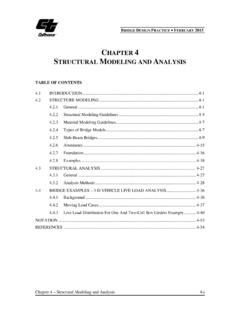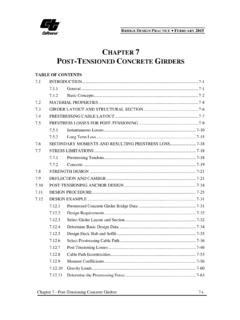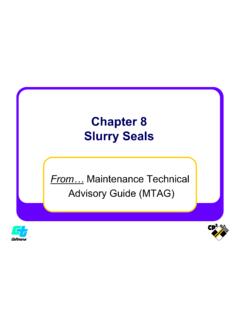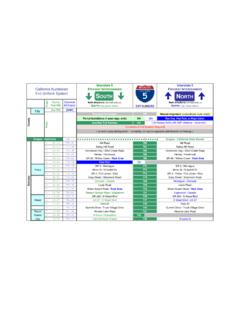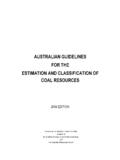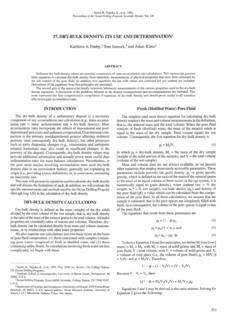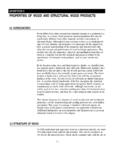Transcription of CHAPTER 3 SOILS
1 CHAPTER 3 SOILS SOILS To verify the adequacy of a shoring system in soil , it is necessary to be familiar with the types of soil in which the excavation is to be made, their properties, and expected behavior. The lateral earth pressure exerted on a shoring system depends on the soil type, its density or consistency, and other factors such as external loads, the type of retaining system used, and the construction procedure. For most projects, the geotechnical investigation and geotechnical report(s) issued by Geotechnical Services should present sufficient information for the Engineer to perform shoring design and analyses. The Engineer must contact Geotechnical Services for guidance when additional soil properties are needed for the design review or when the material encountered during the installation or construction of the shoring system differs from that assumed by the shoring system designer.
2 This CHAPTER discusses the Department s resources for soil information and provides guidance on how to use this information to determine parameters necessary for the design or verification of a shoring system. IDENTIFICATION, CLASSIFICATION, DESCRIPTION AND PRESENTATION The Contractor can obtain soil classification characteristics from the information provided in the Geotechnical Design Report or Foundation Report and corresponding Log of Test Borings, by performing independent sampling and analysis of the soil , or having a competent person classify the soil as per Cal/OSHA Excavation Standard Appendix A to Section soil Classification. As per the Cal/OSHA Appendix A, a competent person is one who is capable of identifying existing and predictable hazards in the surroundings or working conditions which are unsanitary, hazardous, or dangerous to employees, and who has authorization to take prompt corrective measures to eliminate them.
3 That person must have had specific training in and be knowledgeable about SOILS analysis, the use of protective systems, and the requirements of the Standard (Cal/OSHA). The Cal/OSHA soil classification methods include a series of visual analysis as well as a series of manual tests. As per Cal/OSHA Section (c) in Appendix A, the classification of soil deposits shall be made based on the results of at least one visual and at least one manual analysis. 3-1 CT TRENCHING AND SHORING MANUAL Some of the acceptable manual tests are similar to those used in the Caltrans soil and Rock Logging, Classification, and Presentation Manual, including Dry Strength and Pocket Penetrometer methods.
4 The competent person will use the quantitative and qualitative information obtained from the visual and manual tests to classify the SOILS as either Type A (stable rock), Type B, or Type C soil . Depending on the type of soil classified, an unconfined compressive strength value is assigned. Unconfined compressive strength is defined in the Cal/OSHA standard as, the load per unit area at which a soil will fail in compression. It is the Engineer s responsibility to verify that the soil properties used by the Contractor s engineer in their shoring design submittal are appropriate. It is recommended that the Engineer contact the author of the Foundation Report or Geotechnical Design Report to discuss and verify. Caltrans uses geotechnical reports, Log of Test Boring (LOTB) sheets and Boring Records (BR) to present the results of its geotechnical and borehole investigations.
5 LOTB sheets are included in the contract plans for structures and present the boring logs, including soil descriptions and sampling information, whereas a BR is an 8 x 11 sheet attached to a geotechnical report pertaining to roadway facilities (cuts, fills, grading, drainage). The Caltrans soil and Rock Logging, Classification, and Presentation Manual, maintained by Geotechnical Services, presents the Department s practice for identification, classification, description and presentation of soil and rock for all investigations after August 1, 2007. The Manual is available through the Division of Engineering Services/Geotechnical Services at the following website: Correct interpretation of LOTB sheets, BR, and related discussions in geotechnical reports requires familiarity with the Manual.
6 The following is an overview of the Department s soil presentation practice. The descriptive sequence for a soil consists of a group name and group symbol, followed by descriptive components, such as density or consistency, color, moisture etc. The group name and group symbol of a soil , SANDY lean CLAY (CL) for example, is determined using one of the following standards: ASTM D 2488-06, Standard Practice for Description and Identification of SOILS (Visual-Manual Procedure), if laboratory testing is not performed 3-2 SOILS ASTM D 2487-06, Standard Practice for Classification of SOILS for Engineering Purposes (Unified soil Classification System), if laboratory Particle Size Analysis and Plasticity Index tests are performed The descriptive components following the group name and group symbol are defined in the Logging Manual.
7 Section 2 of the Logging Manual presents the Department s practice for identifying and describing soil in the field whereas Section 3 presents the practice of soil classification and description based on laboratory test results. SOILS are identified or classified as either coarse-grained (gravel and sand) or fine-grained (silts and clays). Natural soil consists of one or any combination of gravel, sand, silt, or clay, and may also contain boulders, cobbles, and organics. Coarse-grained SOILS retain more than 50 percent of material on or above the No. 200 sieve ( ). GRAVEL (G) and SAND (S) are further identified or classified according to their gradation as well-graded (W) or poorly graded (P), SILT content (M), or CLAY content (C).
8 Examples of these are Well-graded SAND (SW) or SILTY SAND (SM). Fine-grained SOILS pass more than 50 percent of material through the No. 200 sieve. SILT (M), CLAY (C), and ORGANIC soil (O) are further identified by visual methods or classified by laboratory plasticity tests as low plasticity (L) or high plasticity (H). Examples of these are Lean CLAY (CL) or SANDY SILT (ML). soil PROPERTIES and STRENGTH Characteristics or properties that help predict the effect of a soil on a shoring system include the particle distribution (%gravel, %sand, %fines (silt & clay)), particle angularity, apparent density or consistency (strength), moisture, and unit weight. The Logging Manual presents the Department s standards of measuring or determining these properties either visually (Section 2) or with laboratory testing (Section 3).
9 Typically, the Department uses one or more of the following investigative methods to determine a soil s identification, classification, description and strength: Standard Penetration Test (SPT) with visual/manual methods Cone Penetration Test (CPT) Laboratory Testing 3-3 CT TRENCHING AND SHORING MANUAL STANDARD PENETRATION TEST (SPT) The Standard Penetration Test (SPT) obtains a disturbed sample of soil for visual identification and description, and/or laboratory testing (particle size analysis, plasticity index). The number of hammer blows required to drive the 12k sampler, is referred to as N value. When corrected for the SPT hammer s energy efficiency, it becomes N60. This can be used to determine the apparent density of a granular soil .
10 Empirical relationships to approximate the soil friction angle ( ) and density are shown in Table 3-1. Table 3-1. Properties Granular SOILS Apparent density Relative density (%) SPT, N60 (blows/ft) Friction Angle, (deg) Unit Weight (pcf) Moist Submerged Very Loose 0-15 N60 < 5 <28 <100 <60 Loose 16-35 5 N60 < 10 28-30 95-125 55-65 Medium Dense 36-65 10 N60< 30 31-36 110-130 60-70 Dense 66-85 30 N60 < 50 37-41 110-140 65-85 Very Dense 86-100 N60 50 >41 >130 >75 Note that both the LOTB and BR report the SPT blow count observed in the field as the N value, not N60 as used above to determine the apparent density descriptor. The reader is encouraged to read the Logging Manual on Apparent density and Appendix on SPT prior to using Table 3-1.
